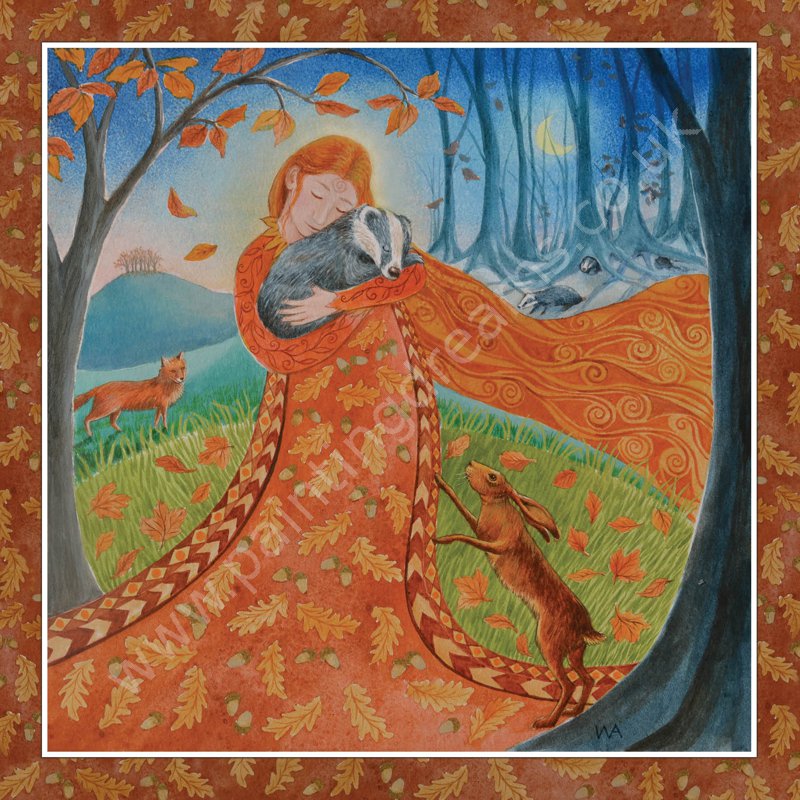Blog
Samuel Carthorne Rivers (September 25, 1923 – December 26, 2011) was an American jazz musician and composer. He performed on soprano and tenor saxophones, bass clarinet, flute, harmonica and piano.
Active in jazz since the early 1950s, he earned wider attention during the mid-1960s spread of free jazz. With a thorough command of music theory, orchestration and composition, Rivers was an influential and prominent artist in jazz music.
Rivers was born in El Reno, Oklahoma, United States. His father was a gospel musician who had sung with the Fisk Jubilee Singers and the Silverstone Quartet, exposing Rivers to music from an early age. His grandfather was Marshall W. Taylor, a religious leader from Kentucky. Rivers was stationed in California in the 1940s during a stint in the Navy. Here he performed semi-regularly with blues singer Jimmy Witherspoon. Rivers moved to Boston, Massachusetts in 1947, where he studied at the Boston Conservatory with Alan Hovhaness.
He performed with Quincy Jones, Herb Pomeroy, Tadd Dameron and others.
more...Dmitri Dmitriyevich Shostakovich (25 September [O.S. 12 September] 1906 – 9 August 1975) was a Soviet composer and pianist. He is regarded as one of the major composers of the 20th century, with a unique harmonic language and a historic importance due to his years of work under Stalin.
Shostakovich achieved fame in the Soviet Union under the patronage of the Soviet chief of staff Mikhail Tukhachevsky, but later had a complex and difficult relationship with the government. Nevertheless, he received accolades and state awards and served in the Supreme Soviet of the RSFSR (1947) and the Supreme Soviet of the Soviet Union (from 1962 until his death).
A polystylist, Shostakovich developed a hybrid voice, combining a variety of different musical techniques into his works. His music is characterized by sharp contrasts, elements of the grotesque, and ambivalent tonality; he was also heavily influenced by the neoclassical style pioneered by Igor Stravinsky, and (especially in his symphonies) by the late Romanticism of Gustav Mahler.
Shostakovich’s orchestral works include 15 symphonies and six concerti. His chamber output includes 15 string quartets, a piano quintet, two piano trios, and two pieces for string octet. His solo piano works include two sonatas, an early set of preludes, and a later set of 24 preludes and fugues. Other works include three operas, several song cycles, ballets, and a substantial quantity of film music; especially well known is the “Waltz No. 2” from the Suite for Variety Orchestra, as well as the suite of music extracted from The Gadfly.
more...The reliable meteor shower’s peak was predicted for the night of August 12/13. But persistent visual observers in North America were deluged with a startling Perseid shower outburst a day later, with reports of multiple meteors per minute and sometimes per second in the early hours of August 14. The shower radiant is high in a dark night sky in this composite image. It painstakingly registers the trails of 282 Perseids captured during the stunning outburst activity between 0650 UT (02:50am EDT) and 0900 UT (05:00am EDT) on August 14 from Westmeath Lookout, Ontario. Of course the annual Perseid meteor shower is associated with planet Earth’s passage through dusty debris from periodic comet 109P/Swift-Tuttle. The 2021 outburst could have been caused by an unanticipated encounter with the Perseid Filament, a denser ribbon of dust inside the broader debris zone.
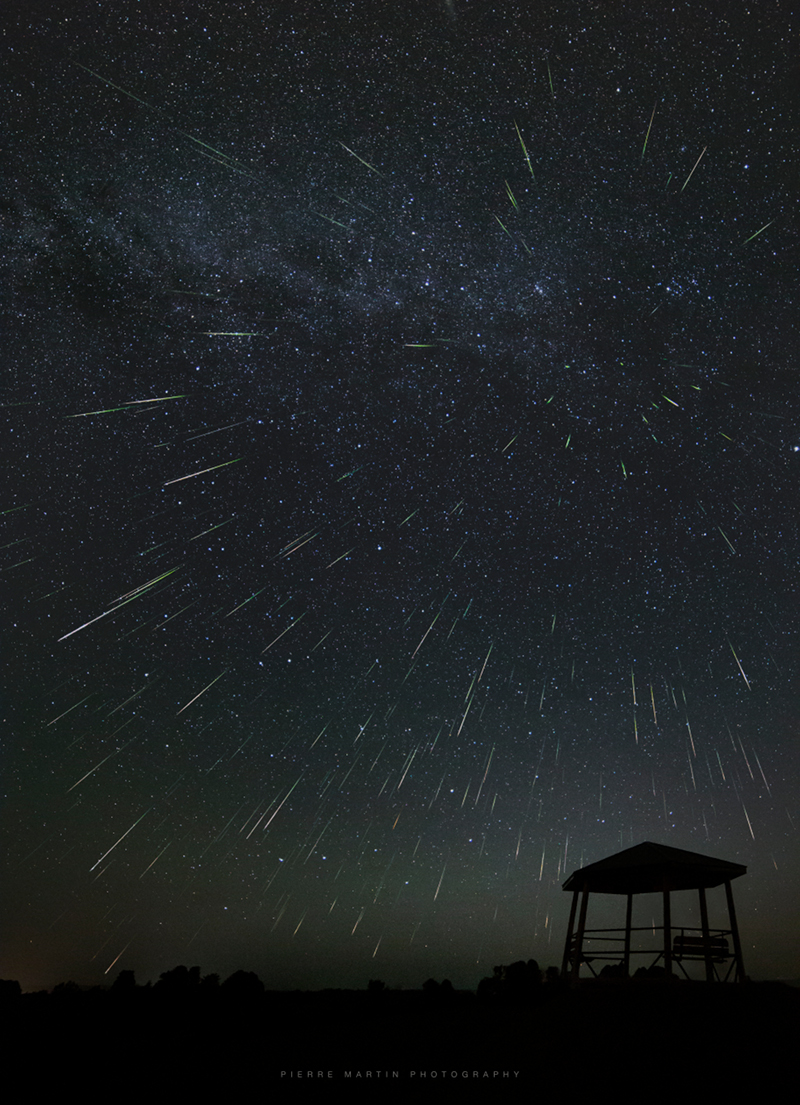
Wayne Maurice Henderson (September 24, 1939 – April 5, 2014) was an American soul jazz and hard bop trombonist and record producer. In 1961, he co-founded the soul jazz/hard bop group The Jazz Crusaders. Henderson left the group (who by then had changed their name to The Crusaders) in 1976 to pursue a career in producing, but revived The Jazz Crusaders in 1995.
In 2007, Henderson took a position with the California College of Music in Pasadena, California.
Henderson had suffered from diabetes and died of heart failure at a Culver City hospital on April 5, 2014 at age 74.
more...Theodore “Fats” Navarro (September 24, 1923 – July 6, 1950) was an American jazz trumpet player. He was a pioneer of the bebop style of jazz improvisation in the 1940s. He had a strong stylistic influence on many other players, including Clifford Brown.
Navarro was born in Key West, Florida, of Cuban, African, and Chinese descent. He began playing piano at age six, but did not become serious about music until he began playing trumpet at the age of thirteen. He was a childhood friend of drummer Al Dreares. By the time he graduated from Douglass High School, he wanted to be away from Key West and joined a dance band headed for the Midwest.
Navarro died of tuberculosis and heroin addiction in New York City on July 6, 1950, and was survived by wife Rena (née Clark, 1927–1975) and his daughter Linda (1949-2014). He was buried in an unmarked grave, number 414, at the Rose Hill Cemetery in Linden, New Jersey.
In 1982, Navarro was inducted into the DownBeat Hall of Fame.
more...Lemon Henry “Blind Lemon” Jefferson (September 24, 1893 – December 19, 1929) was an American blues and gospel singer-songwriter and musician. He was one of the most popular blues singers of the 1920s and has been called the “Father of the Texas Blues“.
Due mainly to his high-pitched voice and the originality of his guitar playing, Jefferson’s performances were distinctive. His recordings sold well, but he was not a strong influence on younger blues singers of his generation, who could not imitate him as easily as they could other commercially successful artists. Later blues and rock and roll musicians, however, did attempt to imitate both his songs and his musical style.
Jefferson was born blind, near Coutchman, Texas. He was the youngest of seven (or possibly eight) children born to Alex and Clarissa Jefferson, who were African-American sharecroppers. Disputes regarding the date of his birth derive from contradictory census records and draft registration records. By 1900, the family was farming southeast of Streetman, Texas. Jefferson’s birth date was recorded as September 1893 in the 1900 census. The 1910 census, taken in May, before his birthday, confirms his year of birth as 1893 and indicated that the family was farming northwest of Wortham, near his birthplace.
https://www.youtube.com/watch?v=WXsxqBhmlFg
more...The rumba originated in Cuba and is a popular Latin American dance floor style, which has sexy and suggestive hip and body movements.
In their original Cuban form they had difficult and complicated rhythms, but by the time they reached Europe, a more simple style had developed. In the 1950s it was adopted by the gypsies, becoming the rumba gitana, which retained all the sensuality and charm of the gypsies. Later, in the 1970s Paco de Lucía and Cameron de la Isla transformed this style, which created an opening for hoards of flamenco fusion groups, such as the Gypsy Kings, who based there fusion on the rumba.
The first flamenco artist to record the rumba was La Niña de los Peines, and one of the best performers of the rumbawas the singer / guitarist Manzanita, although today it is the jerezano singer Capullo de Jerez who excels with his extremely exciting styles of rumbas
more...Born September 23rd 1995. Died June 5th 2002. Diego was a radiant beam of pure Love and inexhaustible energy. His excitement for life was as contagious as his beautiful smile. One could see the unfolding Love of the Universe while gazing in his intense eyes.

Messier 81 (also known as NGC 3031 or Bode’s Galaxy) is a grand design spiral galaxy about 12 million light-years away, with a diameter of 90,000 light years, in the constellation Ursa Major. Due to its proximity to our galaxy, large size, and active galactic nucleus (which harbors a 70 million M☉supermassive black hole), Messier 81 has been studied extensively by professional astronomers. The galaxy’s large size and relatively high brightness also makes it a popular target for amateur astronomers.
M81 (left) and M82 (right). M82 is one of two galaxies strongly influenced gravitationally by M81. The other, NGC 3077, is located off the top edge of this image.
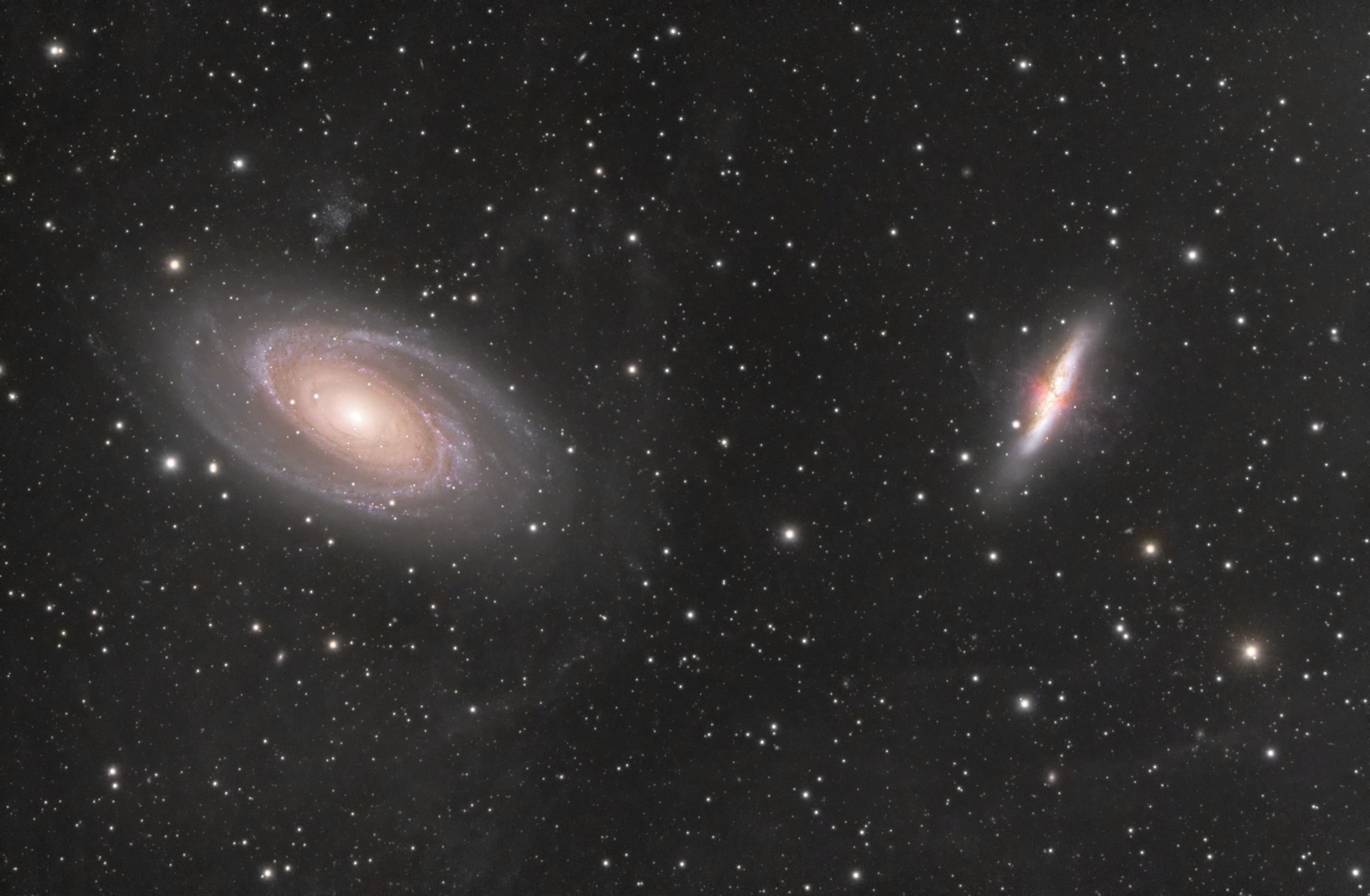
Leslie Coleman McCann (born September 23, 1935) is an American jazz pianist and vocalist.
Winning a Navy singing contest led to an appearance on The Ed Sullivan Show. McCann’s main career began in the early 1960s when he recorded as a pianist with his trio for Pacific Jazz. In 1969, Atlantic released Swiss Movement, album recorded with saxophonist Eddie Harris and trumpeter Benny Bailey at that year’s Montreux Jazz Festival. The album contained the song “Compared to What“, and both the album and the single reached the Billboard pop charts. “Compared to What” criticized the Vietnam War. The song was written by Eugene McDaniels years earlier and recorded and released as a ballad by McCann in 1966 on his album Les McCann Plays the Hits. Roberta Flack‘s version appeared as the opening track on her debut album First Take (1969).
more...Ray Charles Robinson, Sr. (September 23, 1930 – June 10, 2004 Albany, GA) was an American singer, songwriter, pianist, and composer. Among friends and fellow musicians he preferred being called “Brother Ray”. He was often referred to as “the Genius”. Charles was blinded during childhood, possibly due to glaucoma.
Charles pioneered the soul music genre during the 1950s by combining blues, jazz, rhythm and blues, and gospel styles into the music he recorded for Atlantic. He contributed to the integration of country music, rhythm and blues, and pop music during the 1960s with his crossover success on ABC Records, notably with his two Modern Sounds albums. While he was with ABC, Charles became one of the first black musicians to be granted artistic control by a mainstream record company.
Charles’s 1960 hit “Georgia On My Mind” was the first of his three career No. 1 hits on the Billboard Hot 100. His 1962 album Modern Sounds In Country And Western Music became his first album to top the Billboard 200. Charles had multiple singles reach the Top 40 on various Billboardcharts: 44 on the US R&B singles chart, 11 on the Hot 100 singles chart, 2 on the Hot Country singles charts.
Charles cited Nat King Cole as a primary influence, but his music was also influenced by Louis Jordan and Charles Brown. He had a lifelong friendship and occasional partnership with Quincy Jones. Frank Sinatra called Ray Charles “the only true genius in show business,” although Charles downplayed this notion. Billy Joel said, “This may sound like sacrilege, but I think Ray Charles was more important than Elvis Presley“.
For his musical contributions, Charles received the Kennedy Center Honors, the National Medal of Arts, and the Polar Music Prize. He won 18 Grammy Awards, including 5 posthumously. Charles was honored with the Grammy Lifetime Achievement Award in 1987, and 10 of his recordings have been inducted into the Grammy Hall of Fame. Rolling Stone ranked Charles No. 10 on their list of the 100 Greatest Artists of All Time, and No. 2 on their list of the 100 Greatest Singers of All Time.
https://www.youtube.com/watch?v=0rEsVp5tiDQ
more...John William Coltrane (September 23, 1926 – July 17, 1967 Hamlet, NC) was an American jazz saxophonist and composer. Working in the bebop and hard bopidioms early in his career, Coltrane helped pioneer the use of modes and was at the forefront of free jazz. He led at least fifty recording sessions and appeared on many albums by other musicians, including trumpeter Miles Davis and pianist Thelonious Monk. Over the course of his career, Coltrane’s music took on an increasingly spiritual dimension, as exemplified on his most acclaimed albums A Love Supreme (1965) and Ascension (1966). He remains one of the most influential saxophonists in music history. He received numerous posthumous awards, including a Pulitzer Prize in 2007, and was canonized by the African Orthodox Church. His second wife was pianist and harpist Alice Coltrane. The couple had three children: John Jr. (1964–1982), a bassist; Ravi (born 1965), a saxophonist; and Oran (born 1967), also a saxophonist.
Coltrane died of liver cancer at the age of 40 on July 17, 1967, at Huntington Hospital on Long Island. His funeral was held four days later at St. Peter’s Lutheran Church in New York City. The service was started by the Albert Ayler Quartet and finished by the Ornette Coleman Quartet. Coltrane is buried at Pinelawn Cemetery in Farmingdale, New York.
Biographer Lewis Porter speculated that the cause of Coltrane’s illness was hepatitis, although he also attributed the disease to Coltrane’s heroin use at a previous period in his life. Frederick J. Spencer wrote that Coltrane’s death could be attributed to his needle use “or the bottle, or both.” He stated that “[t]he needles he used to inject the drugs may have had everything to do with” Coltrane’s liver disease: “If any needle was contaminated with the appropriate hepatitis virus, it may have caused a chronic infection leading to cirrhosis or cancer.” He noted that despite Coltrane’s “spiritual awakening” in 1957, “[b]y then, he may have had chronic hepatitis and cirrhosis… Unless he developed a primary focus elsewhere in later life and that spread to his liver, the seeds of John Coltrane’s cancer were sown in his days of addiction.
more...
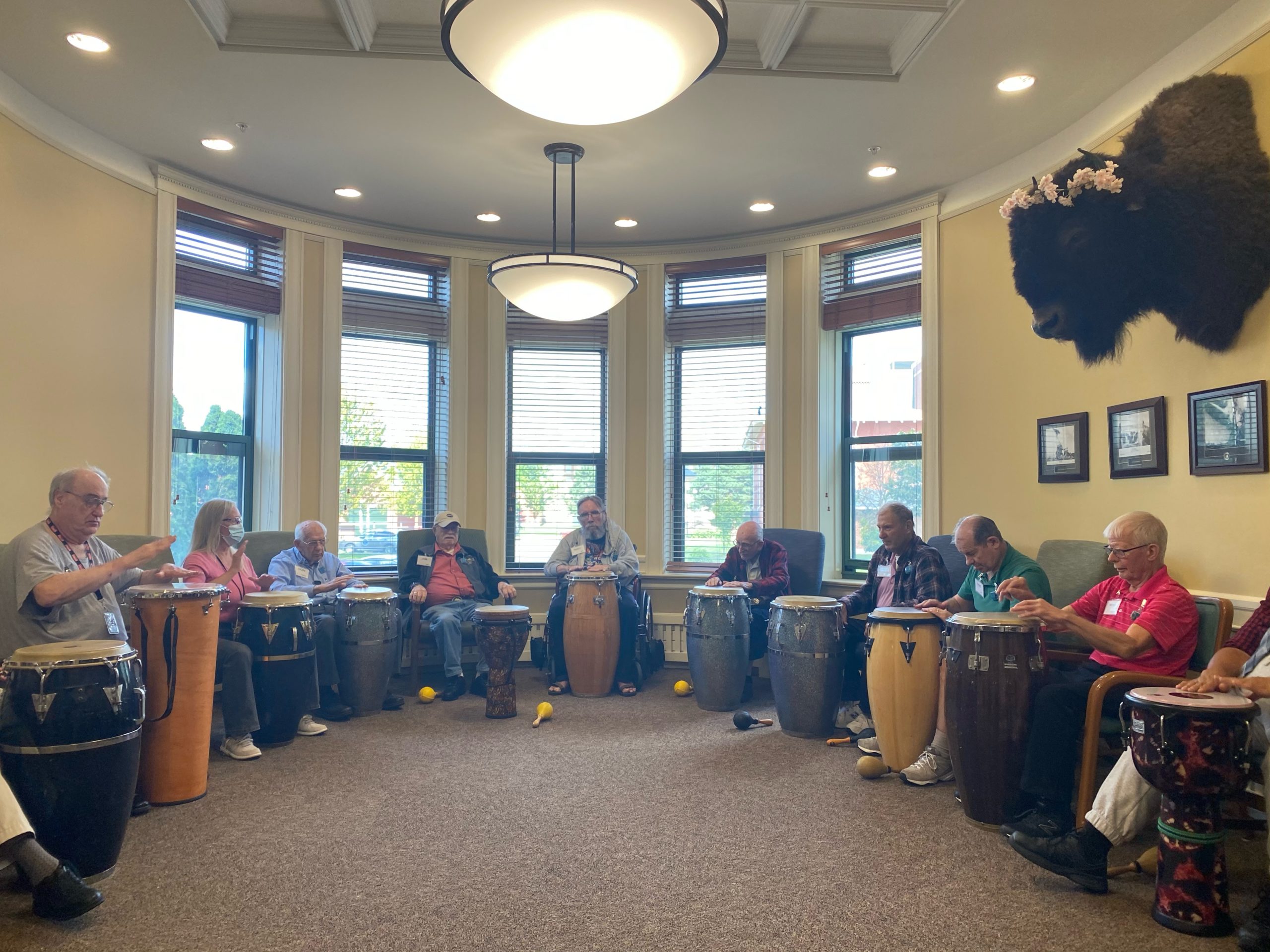
PM1-320 is a small planetary nebula in Cygnus, close to DWB 111, the Propeller Nebula.
It was discovered by Andrea Preite-Martinez in the 1980s.
I believe this to be the first deep high-resolution image of PM1-320.
The outer parts of the nebulosity are very faint, hence 56 hours of OIII integration.
HASH records it’s size as 60 arc seconds.
Image captured on my remote dual rig at Fregenal de la Sierra in Spain between 20 August and 3 September 2021.
Scopes: APM TMB LZOS 152 Refractors
Cameras: QSI6120wsg8
Mount: 10Micron GM2000 HPS
A total of 86 hours image capture (HaOIIILRGB)
More details at: https://www.imagingdeepspace.com/pm1-320.html
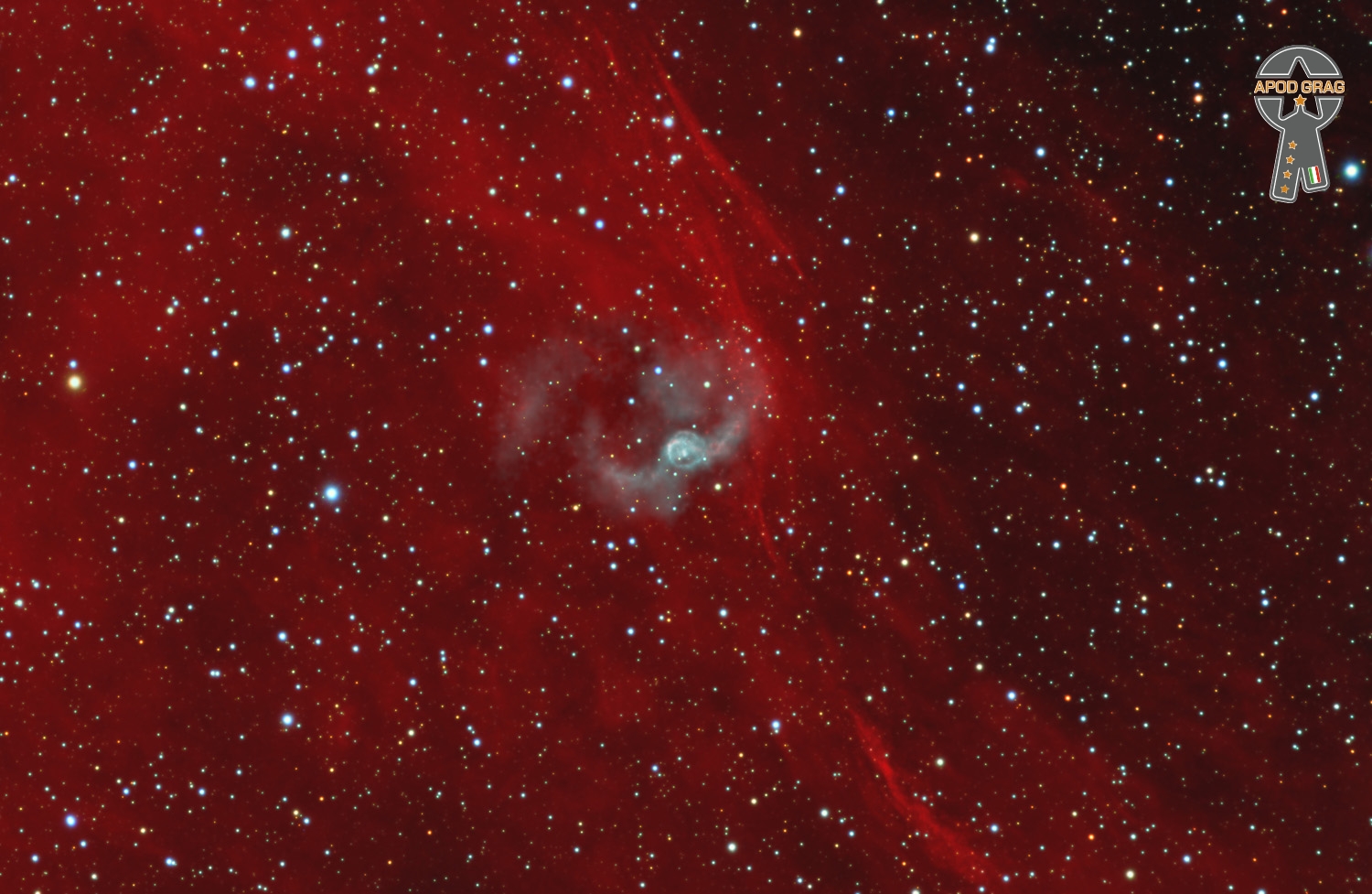
More Posts
- Cosmos M66
- Wild Bill Moore
- Uriel Jones
- Esther Ofarim
- Attila Zoller
- World Music The Zawose Queens
- Daily Roots Tristan Palma
- Rhythm Roots Workshop Residency Ecumen Lakeview Commons Assisted Living and Memory Care in Maplewood PERFORMANCE
- Cosmos Sh2-132
- David Nelson
- Geri Allen
- Chick Corea
- Marcus Belgrave
- World Drumming Babatunde Olatunji
- Daily Roots Prof-I
- Cosmos Rho Ophiuchi, IC 4605 & Antares
- Bernard Purdie
- Hazel Scott
- Shelly Manne
- World Fusion Nibriell
